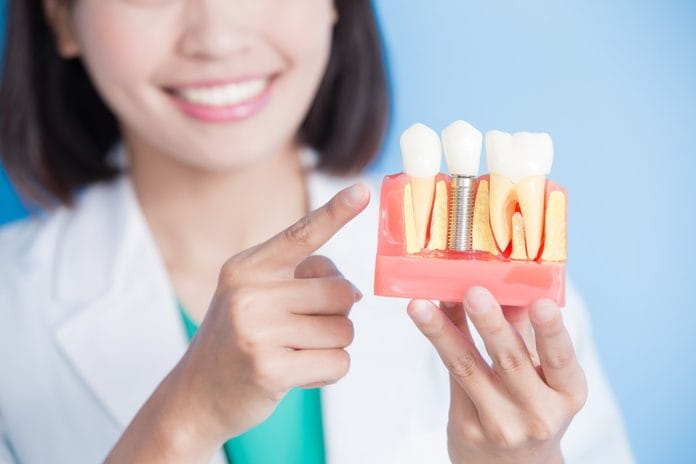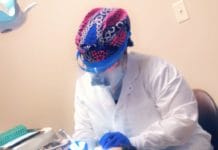Implants are becoming commonplace in our patients, and we need to know how to care for them in office and for patient instruction. At one time, patients presented with bridges; we now know that cutting down healthy opposing teeth to give patients a biting surface is old school and that asking patients to clean under a bridge was wishful thinking.
Now we need to be fluent in the benefits of extraction, bone grafting, and implant placement. As more endodontically treated teeth fail, and more patients experience root fractures, we will see implants being the best go-to treatment. The actual implant placement is relatively comfortable, and healing is usually uneventful. However, the time factor for healing can be daunting for patients, as we live in an immediate world of technology and delivery, and the fee may seem extreme to some, often with limited insurance coverage.
The long-term prognosis and desire to keep teeth for a lifetime is a driving force in implant placement, and as more patients have artificial joints already, it is significantly easier to get past the fear of pain and rejection. The aesthetics of an implant restoration and patient cleanability make for an easy choice.
Hygienists need to stay current on implant care trends in office. In the past, plastic instruments were the norm, but now studies have shown they may leave residue and can lead to implant failure. Titanium scalers are now thought to be the only safe instruments for implant use. They are designed to be thinner, allowing for easier placement and debris removal, without risking leaving material behind. It is suggested to have several sets of titanium implant instruments available for multiple daily uses with time to sterilize and maintain between patients.
Implants can collect biofilm and calculus so as with natural teeth, they must be thoroughly debrided. Some implants may even present with cement remaining on them. All of this needs to be removed in order for the implant to remain stable with full osseous integration.
Susan Wingrove leads research on implant care, treatment and the instruments needed to debride. She has graciously allowed for sharing of her Wingrove 5 Step Implant Assessment, which is paraphrased below:
- Visually examine soft tissue: Assess the tissue that surrounds the implant referred to as the perimucosal seal for inflammation.
- Probe and palpate for signs of infection: Probe gently with an appropriate implant probe and document any areas of bleeding, exudate, and Palpate from what would be apex to crown with fingers placed buccal and lingual to evaluate for bleeding or exudate at the tissue margin.
- Assess for Residue: Examine for calculus, cement, or instrument particles by using a woven floss or dental tape and surrounding the implant and sliding into the tissue, using a “shoeshine” movement to evaluate for fraying floss or roughness on the implant. In either case, debridement will be necessary to alleviate the issue.
- Assess for Mobility, Pain and/or Occlusion
- Assess Bone Level: Yearly radiographs are necessary to compare the bone height; vertical bitewing and periapical radiographs are ideal, though a traditional bitewing may be used. Refer back to the bitewing and periapical taken one-year post-restoration as that is the baseline.
This 5-step procedure should be done at each recall appointment to ensure implant health. When residue is found, only titanium implant scalers should be used for debris removal to ensure implant integrity. Polish only with a rubber cup and non-abrasive paste to maintain the integrity of the crown restoration material. Follow up with polishing for stain removal. Always document your findings and note any changes in the implant or restoration, as follow up and referral may be needed.
Many patients have not been given implant-specific home care techniques and therefore do not adequately care for the implant. Initially, only manual, extra soft brushes should be used in the surgical site so as not to disturb healing, and flossing the area should be avoided. Both manual and power brushes are acceptable after the site has had adequate time to heal. Frequently, patients express alarm that the implant itself is smaller than the natural tooth and it can cause anxiety that something may be amiss.
Stress that thorough plaque removal is essential to implant maintenance and that any signs of swelling, bleeding or pus require an evaluation, and should be regarded as immediate cause for follow-up in the office. Rubber tip stimulator use or digital massage may be added to ensure the papilla fill the interproximal space and avoid the dreaded black triangle. Patients will want optimal gum health to avoid food traps and maintain a beautiful aesthetic result. Suggest using only neutral pH toothpaste that is minimally abrasive to maintain the sheen of the restoration. Evaluate the best recare frequency for your patient, ideally starting with every three months for the first year, and then possibly adjusting on a case-by-case basis.
Implants are becoming common, and we should be prepared to treat them and offer patients guidance in care.
SEE ALSO: Bisphosphonate Continues to be Linked to Dental Implant Failure
Now Listen to the Today’s RDH Dental Hygiene Podcast Below:
Reference
Wingrove S. Peri-Implant Therapy for the Dental Hygienist: A Clinical Guide to Implant Maintenance and Disease Complications. 2013. wiley.com















